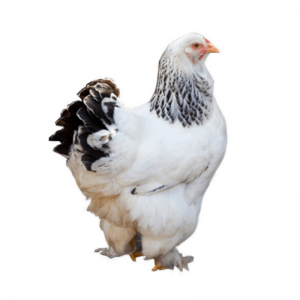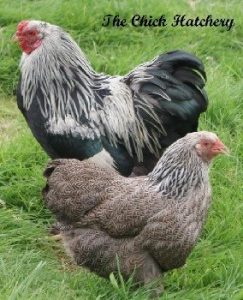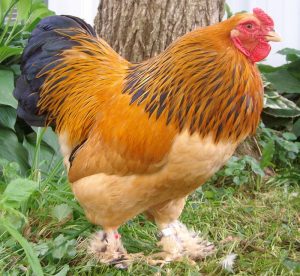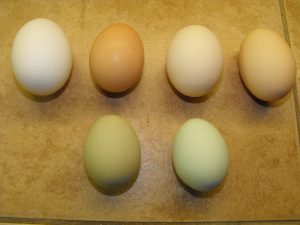Attention: Sometimes we receive a commission when you make a purchase through the links on our site.
The Brahma is a breed of chicken known for its immense size, even given the nickname the “King of Chickens” by many poultry farmers because of it. The bird itself has Asiatic roots, with many of its progenitors originating from Shanghai, where they were imported. This bird has been the staple of many chicken farms in the United States, and to better understand this very influential breed, we’ve summarized everything there is to know about the Brahma chicken.
The History of the Brahma Chicken
Though many historians argue over the exact origins of the Brahma, many of them agree that it originated in the mid-1800’s in China. This bird’s ancestor was originally named the Shanghai, based on the port city where it was originally imported from, and was later known as the Hen Fever breed. The Shanghai was the result of cross-breeding two distinct chicken breeds, the Malay and the Cochin, both of which are of Indian descent.
The Brahmas were first exported to the United Kingdom by George Burnham, a chicken breeder who sent nine “Gray Shanghai” as a gift to Queen Victoria herself. The queen took a liking to these birds, and after such an event, both the popularity and the price of the Brahma increased significantly, from $12 to $100. The breed was later re-exported to the United States, where it would develop even further into the breed we are familiar with today.
The Brahma had many unique names throughout its history and was only given the name “Brahmapootra” by American poultry judges years after its surge in popularity in America, which was later shortened to “Brahma” by the 1850’s.
While in the U.S., the Brahma breed was developed continuously by American poultry farmers, and by the 1930s, new variants of Brahma chickens were available, and was considered to be the best table chicken at the time.
The Brahma chicken would eventually be out-performed both in size and meat quality by newer breeds, hence losing popularity in the next few decades. According to recent reports, however, there has been a surge in popularity in the Brahma chicken among poultry farmers, both domestic and commercial.
Feather Patterns and the Appearance of Brahma Chickens
There are three known variants of Brahma chickens, each with their own specific feather patterns – the light brahma, the dark brahma and the buff brahma. Each variant has contrasting feather patterns, with each distinct form described in depth below.
Light Brahma

This variant is known for its black and white feather patterns contrasted against a grayish tone. The feathers on its saddle area has lightly-toned striping, whereas its hackle feathers have black striping. Its black tail is laced with distinct white feathers.
Dark Brahma

The Dark Brahma chicken has black strips on its saddle feathers, whereas its hackles are silver in color. Its body, breast and tail are a solid black, dark gray or dark brown in color. Black and medium grey penciling can be seen on its breast, back, body and wings. Hens generally have a distinct coloration as well, with the hackle feathers being black laced with white and slight gray penciling.
Buff Brahma

This variant is one of the most popular, due to its uniquely warm coloration. Its body generally has light brown or orange coloration, with its breast a lighter shade of its main color. Its hackle feathers tend to be black with light striping, as does its tail.
Other Variants
Recently, many breeders have created new variants, including the Gold Partridge, the White and the Blue Exchequer. Not many of these variants have reached mainstream popularity, however, but with the amount of development the Brahma has been enjoying in the United States, it will only be a matter of time before new variants, known and unknown, will be thrust into the spotlight.
The Brahma’s Temperament
Despite its large size, the Brahma is a non-aggressive and gentle bird. It is generally calm, friendly and docile, making it easy to handle, especially for kids. Keeping these birds in confinement generally isn’t an issue, so long as they have easy access to food. Because of their thick feathering, they do well in colder climates, and would actually prefer to live in a cool and moist environment. Muddy and swampy areas can be problematic to this breed, however.
Brahma Eggs

During the 1850’s to 1930’s, the Brahma was typically bred for the table as it can feed a large family inexpensively due to its large size. Nowadays, however, they’re generally kept for egg production, since the hens are able to produce enough eggs to feed a small family. Brahma hens typically lay 3-4 eggs a week, even during the winter months, when other breeds stop laying. Brahma eggs tend to range in size from medium to large, and the hens typically lay eggs after the age of 6 – 7 months.
Brahma Chickens for Domestic Breeding
A Brahma chicken can be suitable for you if you plan on keeping domesticated poultry. Due to its calm and docile nature, it can integrate fairly well with your family, even ones with kids and pets. The coop made for the Brahma should be larger than what the typical hen would be kept in, due to their size, with ample space for them to lay their eggs.
Brahma also maturely slowly than most chicken breeds would, due to their immense size. Despite this, however, their chicks hatch quickly, and feather rapidly compared to other chicks. Chicks are typically inexpensive to buy, costing between $3-$4 per chick at a hatchery.
Final Thoughts
The Brahma chicken’s moniker as the King of Chickens is not without merit, due to its size. If you plan on keeping one, however, you will have to make the right preparation in order to keep one safely. You will have to modify the coop to accommodate this large bird, and the amount of feed they consume is far greater, costing more money. During the colder and wetter months, you will have to take special care, as their thicker feathers, especially those around their feet, will get covered with mud, making it difficult for them to move. The Brahma chicken is an exceptional bird to keep, but taking the right preparations is needed for a happy animal, and a happy keeper.
